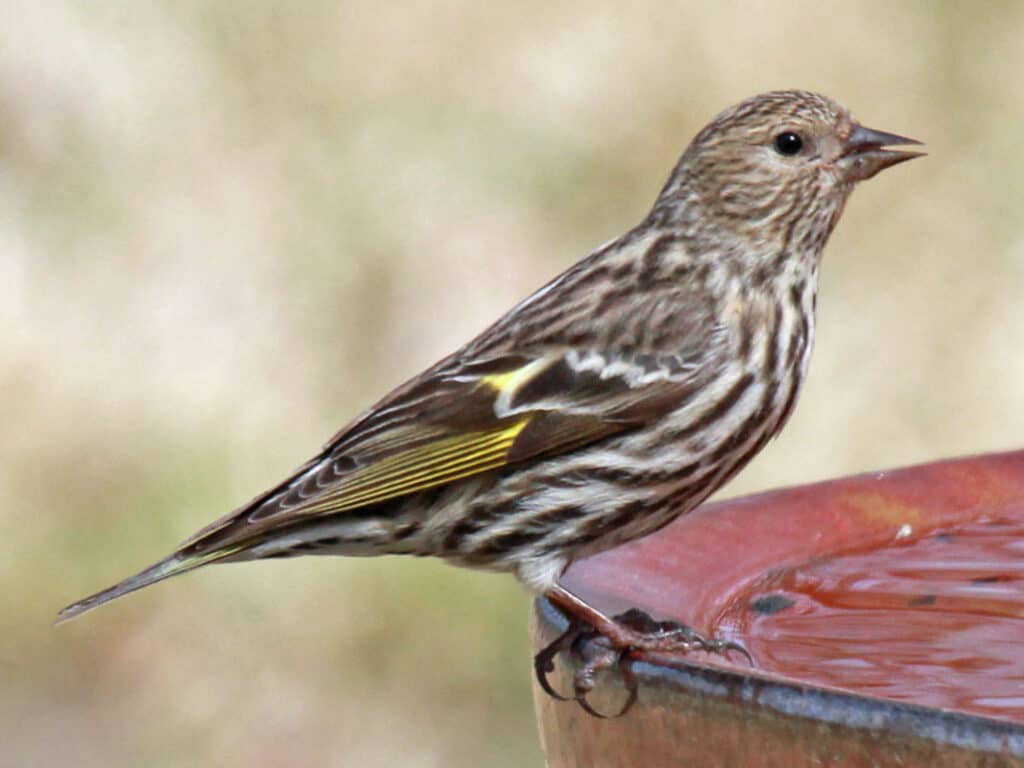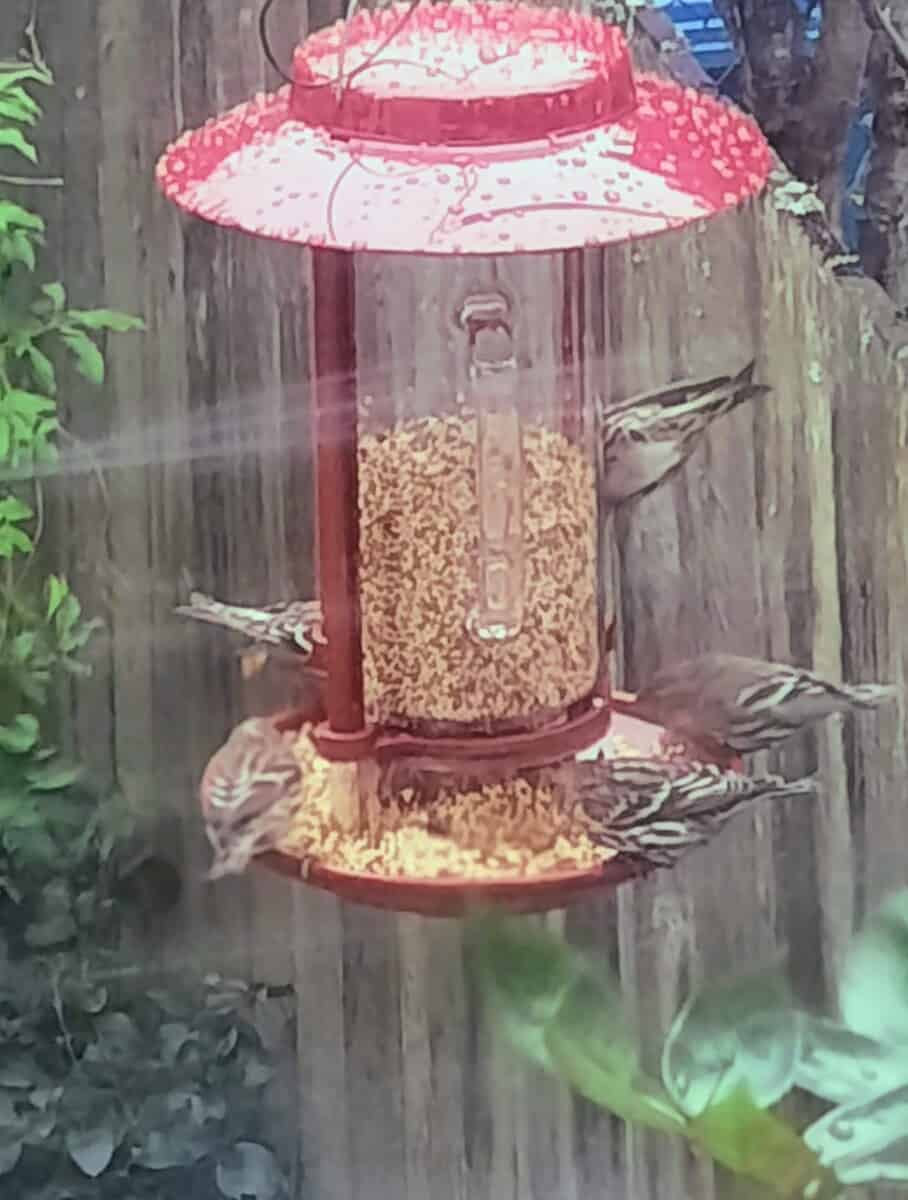Here in the Pacific Northwest, Pine siskins have been dying from a Salmonella outbreak this winter. We’ve found over 125 dead in my city alone. Bird feeders need to be kept clean and the seeds should be kept dry. Otherwise, diseases such as salmonella can spread quickly.
We can keep our wild birds safe and disease free by providing clean and healthy bird feeders. Here are four simple steps you can follow:
- Choose an appropriate feeder with rain protection,
- Keep your seeds dry and fresh,
- Clean your feeders at least once a month,
- Use a variety of feeder types to help various species and to reduce crowding.

You may be surprised to learn that some birds, such as Pine Siskins, are especially susceptible to Salmonella. Imagine a world without the antics of these little flying dinosaurs all around us! Watching them empty our feeders reminds us how important it is to keep our birds healthy – especially during the cold months of winter.
How to Keep Wild Birds Healthy
FIRST PRIORITY: Buy a feeder that has rain and snow protection.

Wet seed grows mold and spreads diseases such as salmonella, avian pox, aspergillosis, and trichomoniasis. These diseases kill the birds we are trying to help during the winter and migration periods.
Salmonella is contagious to humans and pets. Wet or fallen seeds and droppings should be carefully cleaned up and disposed of in the garbage.
A large collecting tray, or a large cookie baking sheet, catches the mess and can be emptied each evening into the garbage, making clean up easier. Please remember to wash hands carefully afterwards so you stay healthy.
How to clean your feeder
Here are our recommended steps to keeping your feeder clean. Try to perform these at least once a month, and preferably every week or two.
- First, discard any remaining seeds,
- Using soap and water, clean all nooks and crannies,
- Wash a second time using a 10 per cent bleach solution,
- Rinse and air dry.
Bird Feeder Tips
Watch my video about the best bird feeders I’ve found after trying several types for over two months, along with some tips for use.
EASIEST Bird Feeders:
Suet Block Cage:
Pros:
- Seeds are protected from water by the suet.
- Very little seed is wasted.
- Attractive to Blue jays, Flickers, Woodpeckers and smaller birds.
- Easily prepared at home.
Here’s a quick and easy recipe for making your own suet at home:
- Black oil sunflower seeds are a favorite. Put 2 inches of seeds into a yogurt container and adding melted shortening to cover seeds,
- Place into the fridge until solidified,
- Pop the block into one of the easily available hanging cages.
Con: Needs to be protected from greedy squirrels!
Hummingbird Feeder
- Buy a well- made red feeder from a reputable store that won’t fall apart and can be easily cleaned. They are not expensive.
- Syrup is made by boiling one cup of water and stirring in ¼ cup of plain sugar.
- When cooled, pour into the feeder.
- Hang in a spot that cats and squirrels can’t reach
Seed Feeders
- Consider three or more well designed feeders as over-crowding spreads disease. Instead of buying one expensive feeder for a hundred dollars you can buy several less expensive feeders and PREMIUM BIRD SEED that costs a little more but isn’t tossed around as much.
- Premium seed mix won’t be packed with fillers like corn, oats or wheat that the birds scatter on the ground and make a mess with.
- The best feeder for small seed with lots of millet is a tube feeder with tiny slits that prevent the seeds from falling out.
Extra Tips to Keep In Mind
- Black oil sunflower seeds are healthy, and birds love them. They need at least ¾ inch (1.8 cm) feeder holes. Check to see if woody stems remain mixed in with the sunflower seeds – they plug up the holes.
- Plastic may not look as natural as wood, but it is easier to clean. Clean monthly. Use gloves and wash with soap, then a weak bleach solution, 1/9: one part bleach to nine parts water. Rinse and dry completely with a paper towel.
- The less seed spilled from your feeder, the less cleanup you’ll have. No one wants to attract mice or rats into the home!
- To save work refilling seed, buy a good-sized feeder. It’s amazing how fast those little birds will empty a small feeder!
Bird Feeder Problems to Avoid:
- Feeders that allow seed to get wet and potentially moldy
- Feeders that can’t be easily cleaned
- Feeders that spill seed everywhere and attract rodents
- Feeders that are too small and run out of seed quickly
In this video, I present some bird feeder problems to avoid:
Feeders Can Make Great Gifts for Seniors
Seniors love to have the opportunity to watch birds outside their windows! In our town there’s a wonderful program that encourages people to donate feeders to residents of retirement homes and assisted living establishments.
If you are kind enough to give a grandparent or elder loved one in your life a bird feeder, please explain the importance of cleaning.
If the senior can’t do the cleaning, please organize a cleaner to avoid the heartbreak of dead birds!
Thanks for your interest in keeping our wild birds safe!

